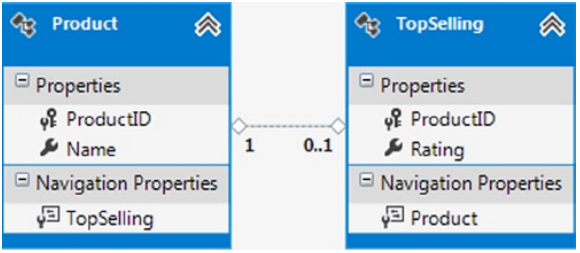《Entity Framework 6 Recipes》中文翻译系列 (16) -----第三章 查询之左连接和在TPH中通过派生类排序
翻译的初衷以及为什么选择《Entity Framework 6 Recipes》来学习,请看本系列开篇
3-10应用左连接
问题
你想使用左外连接来合并两个实体的属性。
解决方案
假设你有如图3-11所示的模型。

图3-11 一个包含Product和TopSelling的模型
畅销产品有一个与之关联的TopSelling实体。当然,不是所有的产品都是畅销产品。这就是为什么关系为零或者1。当一个产品为畅销产品时,与之关联的topSelling实体包含一个用户评级。你想查找和呈现所有的产品,和与之关联的热销榜单实体,即使产品不是一个畅销产品。如果产品没有相关联的热销榜单,我们就简单地用0来设置用户评级。 在数据库中,这叫做左外连接。
代码清单3-22演示了三种略有不同的方法来解决这个问题。
代码清单3-22. 两个实体间的左外连接
using (var context = new EFRecipesEntities())
{
// 删除之前的测试数据
context.Database.ExecuteSqlCommand("delete from chapter3.topselling");
context.Database.ExecuteSqlCommand("delete from chapter3.product");
// 添加新的测试数据
// 注意p1没有与之关联的TopSelling实体
var p1 = new Product { Name = "Trailrunner Backpack" };
var p2 = new Product
{
Name = "Green River Tent",
TopSelling = new TopSelling { Rating = }
};
var p3 = new Product
{
Name = "Prairie Home Dutch Oven",
TopSelling = new TopSelling { Rating = }
};
var p4 = new Product
{
Name = "QuickFire Fire Starter",
TopSelling = new TopSelling { Rating = }
};
context.Products.Add(p1);
context.Products.Add(p2);
context.Products.Add(p3);
context.Products.Add(p4);
context.SaveChanges();
} using (var context = new EFRecipesEntities())
{
var products = from p in context.Products
orderby p.TopSelling.Rating descending
select p;
Console.WriteLine("All products, including those without ratings"); foreach (var product in products)
{
Console.WriteLine("\t{0} [rating: {1}]", product.Name,
product.TopSelling == null ? ""
: product.TopSelling.Rating.ToString());
}
} using (var context = new EFRecipesEntities())
{
var products = from p in context.Products
join t in context.TopSellings on
//注意,我们如何将结果集投影到另一个名为'g'的序列中,以及应用DefaultIfEmpty方法
p.ProductID equals t.ProductID into g
from tps in g.DefaultIfEmpty()
orderby tps.Rating descending
select new
{
Name = p.Name,
Rating = tps.Rating == null ? : tps.Rating
}; Console.WriteLine("\nAll products, including those without ratings");
foreach (var product in products)
{
Console.WriteLine("\t{0} [rating: {1}]", product.Name,
product.Rating.ToString());
}
} using (var context = new EFRecipesEntities())
{
var esql = @"select value p from products as p
order by case when p.TopSelling is null then 0
else p.TopSelling.Rating end desc";
var products = ((IObjectContextAdapter)context).ObjectContext.CreateQuery<Product>(esql);
Console.WriteLine("\nAll products, including those without ratings");
foreach (var product in products)
{
Console.WriteLine("\t{0} [rating: {1}]", product.Name,
product.TopSelling == null ? ""
: product.TopSelling.Rating.ToString());
}
} Console.WriteLine("\nPress <enter> to continue...");
Console.ReadLine();
}
代码清单3-22的输出如下:
Top selling products sorted by rating
Prairie Home Dutch Oven [rating: ]
Green River Tent [rating: ]
QuickFire Fire Starter [rating: ]
Trailrunner Backpack [rating: ]Top selling products sorted by rating
Prairie Home Dutch Oven [rating: ]
Green River Tent [rating: ]
QuickFire Fire Starter [rating: ]
Trailrunner Backpack [rating: ]Top selling products sorted by rating
Prairie Home Dutch Oven [rating: ]
Green River Tent [rating: ]
QuickFire Fire Starter [rating: ]
Trailrunner Backpack [rating: ]
原理
在代码清单3-22中,我们展示了三种不同的方法来处理这个问题。第一种方法最简单。因为实体框架会为关联的实体自动创建join连接,它是基于模型创建时被创建的导航属性。这两个实体的关联为1-0...1,这意味着,实体框架在自动生成SQL查询时,会在这两个实体间包含一个左外连接。当product实体被实例化时,任何与之关联的topSelling也会被实例化。导航属性topSelling也会被设置为相关联的实体,如是不存在topSelling就为null。如果给定的产品不存在与之关联的topSelling实体(也就是说,它没有被评为畅销产品)。我们会简单的分配一个0值给产品的评级。
在某些情况下,你想连接的两个实体间可能没有一个关系(对实例而言,是一个导航属性)。这样的话,你可以显式连接实体。把结果集投影到一个匿名类型。我们之所以需要将结果集投影到匿名类型,是因为没有关联的两个实体间没有导航属性。否则我们不可以引用相关联的实体。
在第二段查询的代码中演示了这种方法。通过键ProductId连接两个实体,然后把结果集投影到一个新的名为'g'的序列中。随后,我们在g上应用DefaultIfEmpty()方法,当g为空时,它会用null值填充。毫无疑问,当SQL语句被产生时,两个实体间将会包含一个左外连接。我们通过一个orderby从句,让结果集根据rating排序。最后,我们将结果投影到一个匿名类型。
在第三中方法中,我们展示了在Entity SQL中,如何更明确地使用左外连接。在查询中嵌入一个Entity SQL语句。
3-11通过派生类排序
问题
当你使用TPH继承映射时,你想通过派生类来给结果集排序。
解决方案
假设你有如图3-12所示的模型。

图3-12 使用TPH继承映射的模型,包含三个派生类弄型
这个模型使用TPH继承映射,它是实体框架一个特性,TPH创建这样的一个继承结构,父类和子类都源至数据库中的同一张表。
在这个示例中,Media实体有一个属性名为Mediatype,它被用作TPH结构中的鉴别属性。MediaType的值决定着数据库表中的行被映射到哪个派生类型(Article,Picture,或者Video)。鉴别列的值为1时代表Article类型,为2时代表Video类型,为3时代表Picture类型。因为这个属性被用来决定派生类型,它将不在Media实体中显示。
我们在代码清单3-23中使用Code-First,创建了实体类,为了保持示例的简单性,我们只创建了空的派生子对象。因为我只是为了演示在查询中通过派生类型来排序。
代码清单3-23. 父类和子类实体类型
public class Media
{
public int MediaId { get; set; }
public string Title { get; set; }
}
public class Article : Media
{
}
public class Picture : Media
{
}
public class Video : Media
{
}
接下来,在代码清单3-24中,我们创建了数据库上下文对象,它是我们凭借实体框架中Code-First方法的入口。注意,如何在OnModelCreating方法中,使用FluentAPI(换句话说就是将扩展方法链接起来创建一个操作)。显式映射鉴别列,MediaType,到子类型。
代码清单3-24 DbContext对象
public class EFRecipesEntities : DbContext
{
public EFRecipesEntities()
: base("ConnectionString") {} public DbSet<Media> Media { get; set; } protected override void OnModelCreating(DbModelBuilder modelBuilder)
{
modelBuilder.Entity<Media>().ToTable("Chapter3.Media"); modelBuilder.Entity<Media>().Map<Article>(x => x.Requires("MediaType").HasValue());
modelBuilder.Entity<Media>().Map<Picture>(x => x.Requires("MediaType").HasValue());
modelBuilder.Entity<Media>().Map<Video>(x => x.Requires("MediaType").HasValue()); base.OnModelCreating(modelBuilder);
}
}
随着Code-First的构件被创建,我们将查询模型中所有的media,并通过派生类型:Article,Video,和Picture进行排序。如代码清单3-25所示。
代码清单3-25.在TPH继承映射中通过类型排序
using (var context = new EFRecipesEntities())
{
//删除之前的测试数据
context.Database.ExecuteSqlCommand("delete from chapter3.Media");
// 添加新的测试数据
context.Media.Add(new Article
{
Title = "Woodworkers' Favorite Tools"
});
context.Media.Add(new Article
{
Title = "Building a Cigar Chair"
});
context.Media.Add(new Video
{
Title = "Upholstering the Cigar Chair"
});
context.Media.Add(new Video
{
Title = "Applying Finish to the Cigar Chair"
});
context.Media.Add(new Picture
{
Title = "Photos of My Cigar Chair"
});
context.Media.Add(new Video
{
Title = "Tour of My Woodworking Shop"
});
context.SaveChanges();
} using (var context = new EFRecipesEntities())
{
var allMedium = from m in context.Media
let mediumtype = m is Article
?
: m is Video ? :
orderby mediumtype
select m;
Console.WriteLine("All Medium sorted by type...\n");
foreach (var medium in allMedium)
{
Console.WriteLine("Title: {0} [{1}]", medium.Title, medium.GetType().Name);
}
} Console.WriteLine("\nPress <enter> to continue...");
Console.ReadLine();
}
代码清单3-25的输出如下:
All Media sorted by type...
Title: Woodworkers' Favorite Tools [Article]
Title: Building a Cigar Chair [Article]
Title: Upholstering the Cigar Chair [Video]
Title: Applying Finish to the Cigar Chair [Video]
Title: Tour of My Woodworking Shop [Video]
Title: Photos of My Cigar Chair [Picture]
原理
当我们使用TPH继承映射时,我们凭借表中一列来区别给定的行代表的派生类型。这一列,通常被称作鉴别列。它不能被映射到实体中的属性。因为我们没有属性包含鉴别值 ,所以,需要创建一个变量来保存鉴别值以便我们进行排序。为了实现这个目的,我们使用了LINQ中的let从句。它创建了一个mediatype变量。我们通过条件语句来将整型的鉴别值分配给这个变量。Article类型的分配1,Video类型的分配2,其它类型的分配3。这里的其它类型其实就是Picture类型,因为没有别的派生类型了。
实体框架交流QQ群: 458326058,欢迎有兴趣的朋友加入一起交流
谢谢大家的持续关注,我的博客地址:http://www.cnblogs.com/VolcanoCloud/
《Entity Framework 6 Recipes》中文翻译系列 (16) -----第三章 查询之左连接和在TPH中通过派生类排序的更多相关文章
- 《Entity Framework 6 Recipes》中文翻译系列 (11) -----第三章 查询之异步查询
翻译的初衷以及为什么选择<Entity Framework 6 Recipes>来学习,请看本系列开篇 第三章 查询 前一章,我们展示了常见数据库场景的建模方式,本章将向你展示如何查询实体 ...
- 《Entity Framework 6 Recipes》中文翻译系列 (12) -----第三章 查询之使用SQL语句
翻译的初衷以及为什么选择<Entity Framework 6 Recipes>来学习,请看本系列开篇 3-2使用原生SQL语句更新 问题 你想在实体框架中使用原生的SQL语句,来更新底层 ...
- 《Entity Framework 6 Recipes》中文翻译系列 (13) -----第三章 查询之使用Entity SQL
翻译的初衷以及为什么选择<Entity Framework 6 Recipes>来学习,请看本系列开篇 3-4使用实体SQL查询模型 问题 你想通过执行Entity SQL语句来查询你的实 ...
- 《Entity Framework 6 Recipes》中文翻译系列 (14) -----第三章 查询之查询中设置默认值和存储过程返回多结果集
翻译的初衷以及为什么选择<Entity Framework 6 Recipes>来学习,请看本系列开篇 3-6在查询中设置默认值 问题 你有这样一个用例,当查询返回null值时,给相应属性 ...
- 《Entity Framework 6 Recipes》中文翻译系列 (15) -----第三章 查询之与列表值比较和过滤关联实体
翻译的初衷以及为什么选择<Entity Framework 6 Recipes>来学习,请看本系列开篇 3-8与列表值比较 问题 你想查询一个实体,条件是给定的列表中包含指定属性的值. 解 ...
- 《Entity Framework 6 Recipes》中文翻译系列 (17) -----第三章 查询之分页、过滤和使用DateTime中的日期部分分组
翻译的初衷以及为什么选择<Entity Framework 6 Recipes>来学习,请看本系列开篇 3-12 分页和过滤 问题 你想使用分页和过滤来创建查询. 解决方案 假设你有如图3 ...
- 《Entity Framework 6 Recipes》中文翻译系列 (18) -----第三章 查询之结果集扁平化和多属性分组
翻译的初衷以及为什么选择<Entity Framework 6 Recipes>来学习,请看本系列开篇 3-14 结果集扁平化 问题 你有一对多关联的两个实体,你想通过一个查询,获取关联 ...
- 《Entity Framework 6 Recipes》中文翻译系列 (19) -----第三章 查询之使用位操作和多属性连接(join)
翻译的初衷以及为什么选择<Entity Framework 6 Recipes>来学习,请看本系列开篇 3-16 过滤中使用位操作 问题 你想在查询的过滤条件中使用位操作. 解决方案 假 ...
- 《Entity Framework 6 Recipes》中文翻译系列 (33) ------ 第六章 继承与建模高级应用之TPH与TPT (2)
翻译的初衷以及为什么选择<Entity Framework 6 Recipes>来学习,请看本系列开篇 6-8 嵌套的TPH建模 问题 你想使用超过一层的TPH继承映射为一张表建模. 解 ...
随机推荐
- viewgager
CycleRotationView:自定义控件,主要功能是实现类似与各种商城首页的广告轮播图.其实像这种比较常见的自定义控件早就满大街了,虽然说"不要重复发明轮子",但是不代表不用 ...
- JS(去掉前后空格或去掉所有空格)的用法
1. 去掉字符串前后所有空格: 代码如下: function Trim(str) { return str.replace(/(^\s*)|(\s*$)/g, ""); } 说明 ...
- 【Asp.Net MVC】日常---路由
想要这样的路由 不带id:http://test.mymong.com/Home/List.html 带id:http://test.mymong.com/Home/Del/561755ba3af24 ...
- Angular内置指令(一)
要注意的是不要把自己开发的指令以ng开头,以免与内置指令冲突 目录:ng-disabled,ng-readonly,ng-checked,ng-selected,ng-href,ng-src,ng- ...
- C#版 Winform界面 Socket编程 Server服务器端
using System; using System.Collections.Generic; using System.ComponentModel; using System.Data; usin ...
- Code Lock[HDU3461]
Code LockTime Limit: 2000/1000 MS (Java/Others) Memory Limit: 131072/65536 K (Java/Others)Total Subm ...
- DOM性能瓶颈与Javascript性能优化
这两天比较闲,写了两篇关于JS性能缺陷与解决方案的文章(<JS特性性能缺陷及JIT的解决方案>,<Javascript垃圾回收浅析>),主要描述了untyped,GC带来的问题 ...
- 如何让eclipse进行智能提示?
1.打开eclipse工具,点击window菜单,选择preferences选项 2.然后,选择Java->Editor->content assist 3.然后在Auto activat ...
- CF-补题1
CF-补题1 1.CodeForces 735C 题意:n个人淘汰赛,两个人可以比赛的条件是:两人打过的场数之差绝对值<2.求冠军最多可以打多少场. 总结:看了题解,转换一下思路.求n个 ...
- Storm 中什么是-acker,acker工作流程介绍
概述 我们知道storm一个很重要的特性是它能够保证你发出的每条消息都会被完整处理, 完整处理的意思是指: 一个tuple被完全处理的意思是: 这个tuple以及由这个tuple所导致的所有的tupl ...
